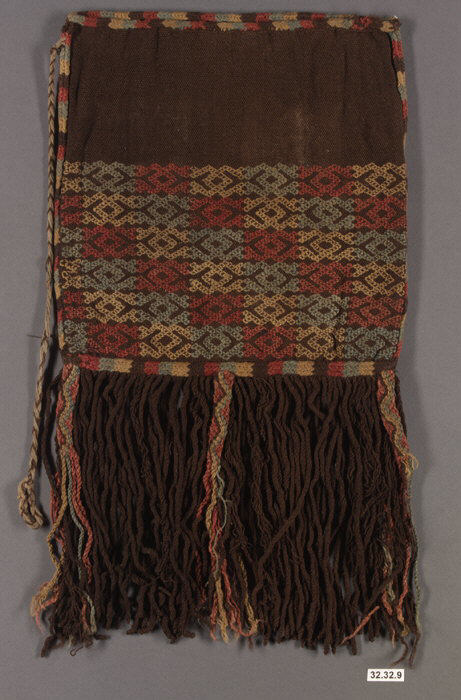Embroidered bag with fringe
Scholars have learned much about the fabrics used by ancient Peruvians because the arid costal environment is excellent for the preservation of organic materials. Not only were sumptuous outer garments such as tunics and mantles preserved, but many accessories such as belts, hats, sashes, and, as illustrated here, elaborate bags for carrying coca leaves have been found. In this example woven on the south coast of Peru by a Nasca artist or artists, a brown cloth was embroidered with yellow, blue, and red threads to form six bands of opposing geometrical figures, perhaps representing stylized frogs. The textile was then folded, and the sides, bottom, and top finished with cross-loop stitching using the same colors deployed on the surface of the bag. The brown fringes represent an unwoven selvage edge. Accessory tubular element reflecting the overall color scheme were subsequently attached. Finally, a cord used to close the bag was added to upper left corner.
Chewing coca leaves with quicklime or ash releases cocaine hydrochloride which quickly enters the circulation and produces a mild narcotic effect (Plowman, 1984). The drug is believed to provide energy and mask hunger (Plowman, 1984). In present-day traditional societies, chewing coca leaves involves both social and religious rituals and it is reasonable to think that this was true thousands of years ago (Sharratt, 2014).
References and Further Reading
Allen, Catherine J. The Hold Life Has: Coca and Cultural Identity in an Andean Community, 2nd ed. (Washington, 2002).
Dillehay, Tom D., Jack Rosen, Donald Ugent, Anathasios Karathanasis, Víctor Vásquez, and Patricia J, Netherly. “Early Holocene Coca Chewing in Northern Peru.” Antiquity Volume 84 (326) (2010), pp. 939-953.
Lemaitre, Serge. Inca: Textiles and Ornaments of the Andes. Brussels, Belgium: Ludion. 2018.
Plowman, Timothy. “The Ethnobotany of Coca (Erythroxylum spp. Erythroxylaceae) Advances in Economic Botany” Vol 1. Ethnobotany in the Neotropics (18 September 1984), 94-101.
Sharratt, Nicola. Carrying Coca; 1,500 Years of Andean Chuspas. New York, NY: Bard Graduate Center, 2014.
Stone-Miller, Rebecca. To Weave for the Sun: Andean Textiles in the Museum of Fine Arts. Boston. Boston, MA: The Museum of Fine Arts. Boston. 1992, pp. 96, 98.
Due to rights restrictions, this image cannot be enlarged, viewed at full screen, or downloaded.
This artwork is meant to be viewed from right to left. Scroll left to view more.




